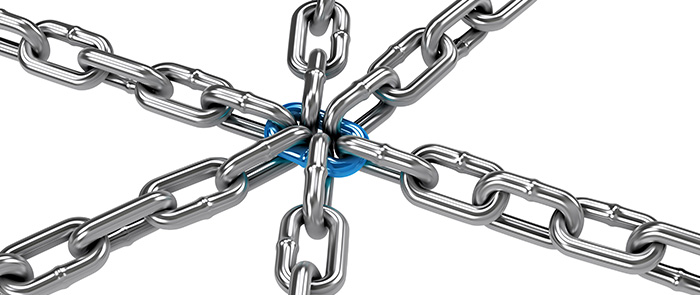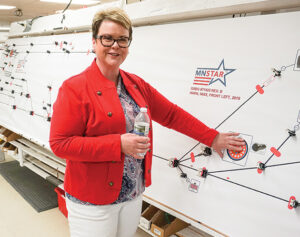Enterprise Minnesota president and CEO Bob Kill interviews supply chain authority Willy Shih, the Robert and Jane Cizik Professor of Management Practice in Business Administration at Harvard Business School. Shih discusses the roots of the current crisis, why it differs from past supply shortages, and how manufacturers can manage their relationships with suppliers now and in the future. He also discusses one possible supply hiccup on the horizon and offers his best advice for manufacturers who want to protect themselves from coming shocks.
Bob Kill: What have we learned about supply chain disruptions since the pandemic?
Willy Shih: We’ve built much more extended supply chains, and they have much less margin for error than people generally realized. Therefore, we have suffered on the resilience side. I know there’s a lot of criticism of supply chains, but all things considered, people in this country by and large have not starved throughout the pandemic. We may not have gotten the choices we wanted, and oftentimes we had to wait, but by and large, supply chains function.
At the same time, we learned about the geographic extent of supply chains. There was a much greater dependency on distant sources and much less slack capacity in the system. I don’t think people really appreciated the implications of that until their backs were up against the wall. All of this has been driven by manufacturers being more price competitive and cost competitive, but that has led us into the situation that we’re in now.
Were we headed for some disruptions before the pandemic and this just really made them more visible?
We’ve had disruptions repeatedly over the last couple of decades. There was the Tōhoku earthquake and tsunami in east Japan in March 2011, for example, which disrupted a lot of automotive supply chains. Especially because it took out production of a significant percentage of the world’s automotive microcontrollers. It also took out a supplier of a paint component used to make black paint sparkly, which made it hard for people to paint cars black. Then the flooding in Thailand that year disrupted the supply for hard disc drives.
So, we’ve had those disruptions before. What we haven’t had is the breadth and scale of this disruption. It affected so many suppliers in so many different areas. Because of that, it became visible in just about everything. You had trouble getting a freezer. You had trouble getting a car. You had trouble getting the flavor of soft drink that you wanted. I think it was the scale that really called everybody’s attention to the core questions, but those have been under there all along.

When you think about the pandemic, and now about Ukraine and higher energy costs, where do you see this going?
Think about energy prices, which underpin agriculture. Or the disruption of fertilizer, for example. Those are really broad-based disruptions. I’ve been very skeptical about people who have said this is transitory inflation. Now people are taking that back.
I would remind everybody that many people — and especially a lot of young people — have always lived in a world where we had a pretty benign trading environment. From the late 1980s until about 2016, we had a pretty stable geopolitical environment. We had occasional energy shocks, but those all reverted back to some sense of stability. We had this dramatic expansion of the tradeable sector during that time. Since the late 1990s and early 2000s, we’ve had a huge migration of manufacturing to China, which was one of the reasons for low inflation. We kept costs down by offshoring a lot of production to China. Now the question is, what does it look like going forward?
What are your thoughts on the possibility of moving the production of goods closer to the consumer?
First, let’s talk about the whole re-shoring concept. People say that two decades ago all of this stuff was made in the U.S. — so, let’s bring it back. The big challenge to that is when we off-shored production from the U.S. to a low-cost country like China, you would pick up the equipment, the processes, the know-how, and build a factory in China. You would hire people, set up the supply chain, set up the logistics. All those things cost money. And the cost was paid for in the savings in product cost. Economically it was very straightforward.
After 9/11 kind of induced a recession, a lot of American manufacturers made their numbers by offshoring their production to China. That was really the starting gun on that big wave. It works when you’re going from a high-cost country to a low-cost country. But when you’re going from a low-cost country to a high-cost country, you don’t have those economics behind you.
So, is it at all practical to build a supply chain using almost exclusively American companies and suppliers?
It’s much harder than anybody is admitting right now. There are a lot of hawks who want to disentangle with China, but we are much more entangled than we’d like to be. We’re dependent on China, and China is dependent on the U.S. Much more than they would like to be as well. That will be a source of a lot of stress in the years ahead. Go look in a Walmart, or a Home Depot, or a Target and see how many products come from China. And we don’t have the manufacturing capacity or the capabilities to make a lot of those things. We gave them up, like textile dyeing, or textile manufacturing. And it’s not all in China anymore, either, because it’s moved on to Bangladesh and other countries in south Asia.
Meaning, if you want to do that — build supply chains using almost exclusively American companies — you have to either accept the higher cost and charge more for your product, or you have to find a way to overcome that labor cost differential with productivity. Usually that means automation, or it might mean process reengineering, or adopting a new process technology. But it isn’t free. That’s something I think a lot of people miss on this argument.
Automation can really be a wide range of things; it’s not just robots. What are your thoughts on that?
I think it includes the application of digital technology. So, for example, one area that I’m very keen on is manufacturing of castings. The traditional sandcasting model is actually very amenable to using binder jet printing for the sand tools used to make more complex tools and more sophisticated castings. Another example would be continuous flow manufacturing for fine chemicals or pharmaceuticals, where I think there is a revolution happening.
This idea of process innovation is really important. At the end of World War II, U.S. steel manufacturers were the king of the hill because the Europeans and the Japanese were all in ruins. It also meant that when the Europeans and the Japanese started rebuilding, they were the first to use many advanced methods.
American steelmakers had their open-hearth furnaces. They were fully depreciated, and they were paid for. They were always fearful of having excess capacity because excess capacity is death in that business. So, rather than invest in new technology and equipment, they just stuck with the old, even though the new technology produced better-quality product at lower cost.
We see over and over again where incumbents stick too long with the existing technology. I tell people technological change is an opportunity to unseat the incumbents.
These technology transitions are actually opportunities. That’s when you give new entrants an opportunity. That’s why I say you’ve got to look for those transitions.
When it comes to fixing the supply chain, why doesn’t it work to address the major bottlenecks of the supply chain — for example, opening ports 24 hours a day?
A lot of people try to treat the symptoms. They see a bottleneck in the port and think we need a bigger port, or we need the port to open 24 hours a day. Well, it turns out the real bottleneck was not the port. The real bottleneck was that the warehouses and distribution centers they were going to were full. They didn’t have anywhere to empty out the containers. Then the containers would stay, and they would have to stay on the truck chassis. And then there wouldn’t be enough truck chassis to go back and pick up more containers. So, one of the challenges in general is that people who work on supply chains often just see their piece. If you look at the whole system, you know where the bottlenecks are in the whole system, and you might get a different view.
What portion of this is tied to the labor shortage?
We’re definitely seeing that the labor shortage is pervasive at multiple levels. But you also see us moving toward new distribution models. Amazon has recently admitted that maybe they were expanding a little too fast — but they hired an enormous number of people. Walmart hired an enormous number of people. If all those hirings stick, that adds to the competition for labor. So certainly, demand for labor has gone up.
The other thing that a lot of people don’t really focus on is labor productivity. I’m not trying to be critical here, but you have truckers waiting to pick up their boxes. And they have federal limits on how many hours they can drive per day. Having them wait is very wasteful. They don’t like it either because they get paid by the load, not by the hour. There are a lot of those types of inefficiencies, and congestion has just made everything worse. I don’t think it’s one problem anywhere, but certainly labor shortages have not made things better. There isn’t a manufacturer or a company I know who isn’t struggling to hire people right now.
Should even small- and medium-sized companies think about having a dedicated supply chain executive?
With many of the things that happened, you would’ve had an advantage or a head start on the problem by having somebody watch what was happening close to the ground. Companies that did well early on are the ones who had their ear to the ground on these things.
If you rely on a third-party logistics supplier to provide all of that — and many small companies have no choice but to do that because it’s beyond their capabilities — you are several layers away from what’s going on. You get aggregated with everybody else. I think it’s advantageous to have that expertise and pay closer attention to the logistics side of the supply chain. It gives me better visibility on what’s going on. Also, it buys some time and better ability to anticipate what’s coming at me.

With so much uncertainty, particularly with prices, should manufacturers try to renegotiate their contracts with suppliers or customers so they have more flexibility?
I hear that people are changing their contracting practices. In other words, we saw a lot of the automakers say they were going to have more strategic relationships with their suppliers. Well, historically they’ve had very transactional relationships with their suppliers, including being able to cancel within very short order windows. Turns out, that did not serve anybody well. To the extent that they can become more strategic with their suppliers, I think that’s helpful.
It also depends on what you mean by a “strategic partnership” with your supplier. This is not just a way to secure more supply now, especially if you just plan to go back to the way things were once shortages ease up. It’s a long-term, cultural change. A more strategic supplier relationship means sharing more information on your actual volume requirements, and sharing your product roadmap so they can get better visibility as well. That means letting the supplier know more about your true needs over a longer time horizon — out several quarters, for example — and doing more collaborative planning. Too much business now is based on a transactional model where there are short “frozen zones” and customers can cancel things in close without significant penalties, as opposed to letting suppliers know a little further out.
Being more strategic is always good. The only question is when people have excess inventory — and this inevitably happens — whether they will have a long memory or a short memory and go back to the way things were.
How much can small- and medium-sized OEM suppliers push for a less transactional partnership with their customers?
It depends on if the OEM thinks they have alternatives. If you have unique capabilities, and your customer needs you, then this is a time when you have more leverage. If your capabilities are less differentiated and the customer can pit you against somebody else, then this is a very bad time. For example, back in April, GM had record earnings. Meanwhile, some of their suppliers were going out of business. When a supplier had their resin cost go up 80%, and wanted to pass some through, GM said no, you have a fixed price contract. My critique of that situation is if you’re the OEM and you don’t recognize that your supplier is being driven to the wall, the next time you need them, they won’t be around. I think that’s a bad practice.
I always point to Toyota here because Toyota continues to act differently from a lot of other automotive OEMs. One supplier told me that Toyota understands what it costs to make something right. They allow that supplier to make a profit. The supplier gives a quote on something and Toyota will either accept it, or they won’t. But they won’t go through this dance that they have to do with the Big Three in Detroit, where the procurement people are rewarded on how much cost they can get out of the suppliers. Short-term, that supplier may not make as much money, but it’s a much more stable business.
At the same time, if you are a supplier to an OEM and you have a differentiated product, you might be in a good position to reap some short-term profits. But then if you press really hard, you’re just giving them an incentive to find a replacement.
Toyota has built networks of suppliers, trying to keep them closer. In some cases, they are actually higher-cost suppliers. They also work with them on process, innovation and continuous improvement.
Do you see more companies trying that?
Yes. The Toyota plant in Georgetown, Ky., is very proud of the number of suppliers they have that are not that far away — in other parts of Kentucky, southern Ohio or southeastern Indiana. It’s funny: The domestic content on some Toyota vehicles made in the U.S. is higher than a lot of vehicles from the Big Three in Detroit. But they analyze those things, and they work with suppliers so that they can deliver those capabilities and be competitive on cost.
It’s as if a lot of American companies adopted part of the Toyota production system, but they didn’t adopt some of those more cultural aspects around partnership. It’s sort of like, I’m going to run a lean, just-in-time production system, but it’s harder when I don’t have the level of trust with my suppliers.
How important is it for CEOs and other executives to play a role in building and maintaining relationships with suppliers?
It’s always useful to view your suppliers as strategic partners. If you count on them to provide key materials and subassemblies, you can help them by understanding their problems, challenges and opportunities. Sometimes the help is just giving them more flexibility. Sometimes the help might be working together on a lot of these problems.
Again, Toyota sets the standard here, because they go out and help suppliers get better. They realize those suppliers not only serve them but their customers as well. We saw during the pandemic how it serves them well to invest in good suppliers. They fared better than many other companies because they took a strategic approach to all these things.
How can manufacturers cultivate those partnerships?
In a race to the bottom on costs, many big OEMs have pushed a lot of this offshore, especially for castings. I have a John Deere tractor, and a lot of the parts come from China. Then China goes through a COVID lockdown and you can’t get those parts. The problem, from the standpoint of a manufacturer like that, is that they have moved the high-volume stuff offshore.
But moving the high-volume stuff offshore gave those same manufacturers the kind of cashflow they needed to modernize. So, the offshore guys tend to have better tools and newer tools, and now you have the poor stepchild at home who doesn’t have the latest tools. If you think that the local partner is important in the long-term, then maybe you need to invest a little bit more in their health by giving them the kind of work that will allow them to sustain investment right now.
Manufacturers will think they can’t compete on cost this way, but then the next time you have this supply chain snafu you can’t get parts from halfway around the world. If you want these local guys to be around, you’ve got to do business with them. If you don’t give them business, don’t expect them to survive.
Do you need the scale of a Toyota to actually establish these kinds of supplier relationships?
It’s possible, but it takes staying power. Especially if people around you need to be convinced. It’s about partnership. I think in the Midwest — and I grew up in the Midwest — people are historically better at working with each other. That’s what it’s about. It’s about working together to solve problems.
Do you see how reducing the carbon footprint could drive a more regional supply chain?
Yes. Very few people in the U.S. have paid any attention to the IMO 2023 regulations. That’s the International Maritime Organization. Starting in 2023, every ship engaged in trade — and remember, 90% of global trade moves on the water — will be subject to IMO regulations. They will have to develop a carbon intensity indicator for each ship. And then from 2023 to 2030 they will have to show annual improvement.
That means that global shipping is not going to be the same starting next year. They’ll either have to install scrubbers or they’ll have to go to something like bioethanol or LNG. I think the reason nobody knows about it is because there are no major U.S. container shipping lines. There are no U.S. people who laid on the tracks to stop that.
Does the overall focus on reducing waste and a carbon footprint represent an opportunity for manufacturers?
I think it will, because more and more companies are focusing on scope one, scope two, and eventually scope three emissions. For small and medium enterprises it is a chance to innovate in technology, both in terms of carbon footprint and productivity. That’s really your chance to capture some of this business, in productivity in particular. People are looking for closer-to-home solutions. In castings, for example, you can use newer technology, be closer to the market, be quicker, and do more complex parts. It’s going to be a challenging market, though, because your customer has to see the value in that too.
If you had one piece of advice for small- and medium-sized manufacturers, based on what’s happened in the world, what would that be?
I’d be looking at how to upgrade my skills. I think it’s essential for smaller manufacturers right now to look at newer technologies, especially digital skills, computer modeling, simulation, things like that. If you want to move into new areas, you have to learn. The number one thing is to focus on upgrading your skills.
…
Featured story in the Fall 2022 issue of Enterprise Minnesota magazine.


